Oz In Pitcher Of Beer
Summary: A product requirements document (PRD) defines the requirements of a particular product, including the product's purpose, features, functionality, and behavior. Information technology serves as a guide for business and technical teams to help build, launch, or marketplace the production.
Building a great product requires tons of research and comprehensive planning. Just where do y'all start? Product managers often start with aproduct requirements document(PRD).
A product requirements document defines the product you are about to build: It outlines the product's purpose, its features, functionalities, and beliefs.
Side by side, you share the PRD with (and seek input from) stakeholders - business concern and technical teams who will help build, launch or market your production.
Once all stakeholders are aligned, the PRD serves every bit a compass, providing clear direction toward a product's purpose while creating a shared understanding amidst concern and technical teams.
Gathering requirements in an agile world
What does the requirements gathering process look similar in an agile world? It sounds catchy - and it is. But don't worry. At Atlassian, we know all about creating PRDs in an active environment. Here are a few things to continue in mind:
Agile requirements are a product owner'due south best friend. Product owners who don't apply agile requirements get defenseless up with spec'ing out every detail to deliver the right software (then cross their fingers hoping they've spec'ed out the right things). Agile requirements, on the other paw, depend on a shared understanding of the customer that is shared between the product owner, designer, and the development squad. That shared understanding and empathy for the target customer unlocks hidden bandwidth for product owners. They tin focus on higher-level requirements and leave implementation details to the development team, who is fully equipped to exercise and then – once more, because of that shared understanding. (Boom.)
Creating a shared understanding among teams
If yous're excited past the idea of a shared understanding, merely haven't a inkling how to create it, effort some of these tips:
- When conducting customer interviews, include a member of the pattern and development teams and then they tin hear from a customer directly instead of relying on the production owner'southward notes. It volition as well give them the chance to probe deeper while the topic is fresh in the customer's mind.
- Make developing and using customer personas a squad try. Each team member has unique perspectives and insights, and needs to empathize how the personas influences product evolution.
- Make issue triage and backlog grooming a team sport too. These are not bad opportunities to make sure everyone is on the same page, and understand why the product owner has prioritized work the way they have.
Desire to give information technology a try? Sign upwardly or log into Confluence >>
Create a customer interview template to document your customer insights. Follow our tutorial to go started on conducting valuable customer interviews:
- Create insighful client interview pages
- Plough info into insights with the Customer Interview Pyramid
Anti-patterns to watch for
- The entire project is already spec'd out in great item before any engineering work begins
- Thorough review and fe-clad sign-off from all teams are required before piece of work even starts
- Designers and developers don't know when requirements take been updated
- Requirements are never updated in the get-go place (because anybody signed off on them, remember?)
- The production owner writes requirements without the participation of the squad
Ok: you lot've discussed a set of user stories with your engineer and designer. Gone back and forth, had a few whiteboard sessions, and concluded in that location are a few more dimensions you demand to consider for this feature that you are working on. Y'all need to flesh out some assumptions yous're making, recollect deeper nearly how this fits in the overall scheme of things and keep track of all the open questions you demand to answer. What next?
Keeping requirements lean with a one-page dashboard
When writing a requirements certificate, information technology'south helpful to utilise a consistent template across the team and then everyone can follow along and give feedback. At Atlassian, nosotros utilize Confluence to create product requirements with the production requirements document template. Nosotros've found that the section below provides "just plenty" context to understand a project'due south requirements and its impact on users:
1. Define projection specifics
Nosotros recommend including high-level direction at the top of the folio as follows:
- Participants: Who is involved? Include the product owner, squad, stakeholders
- Condition: What'south the current land of the program? On target, at hazard, delayed, deferred, etc.
- Target release: When is it projected to ship?
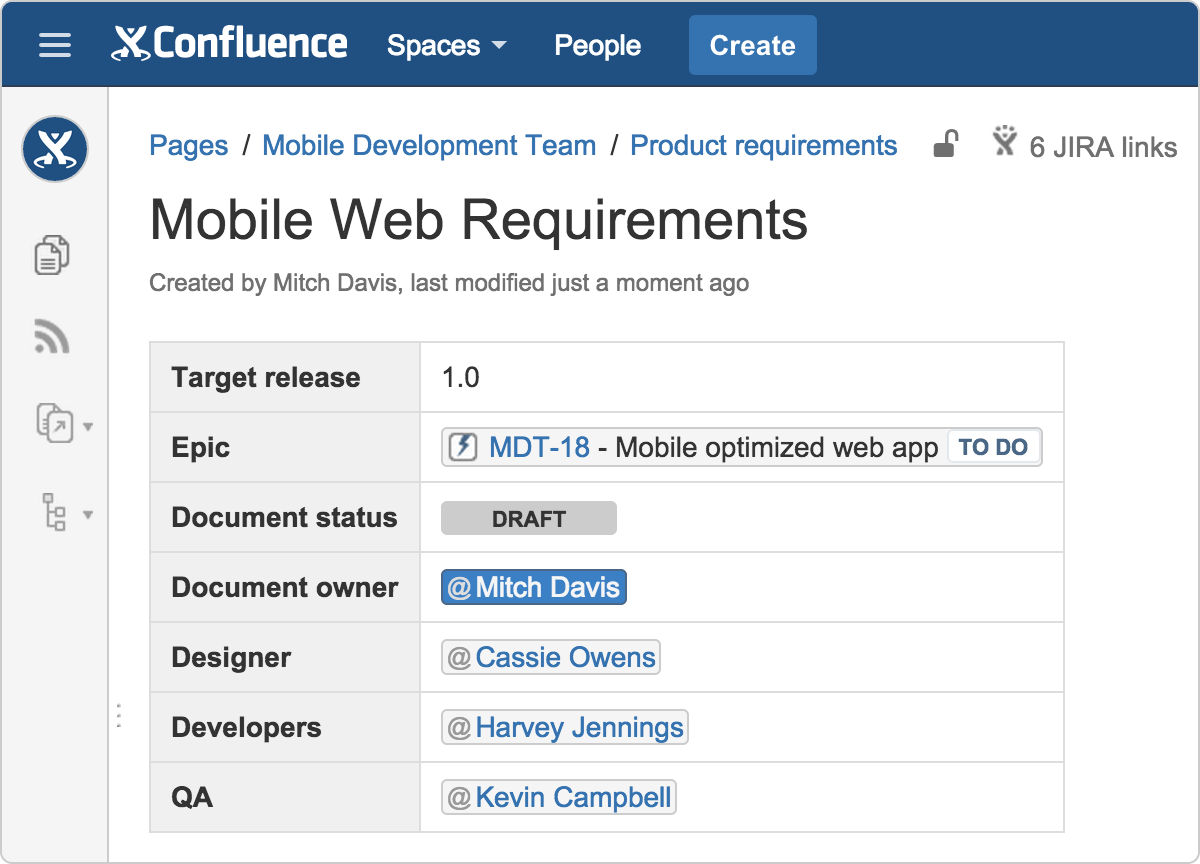
ii. Team goals and business organisation objectives
Get straight to the point. Inform, but don't bore.
three. Background and strategic fit
Why are nosotros doing this? How does this fit into the overall visitor objectives?
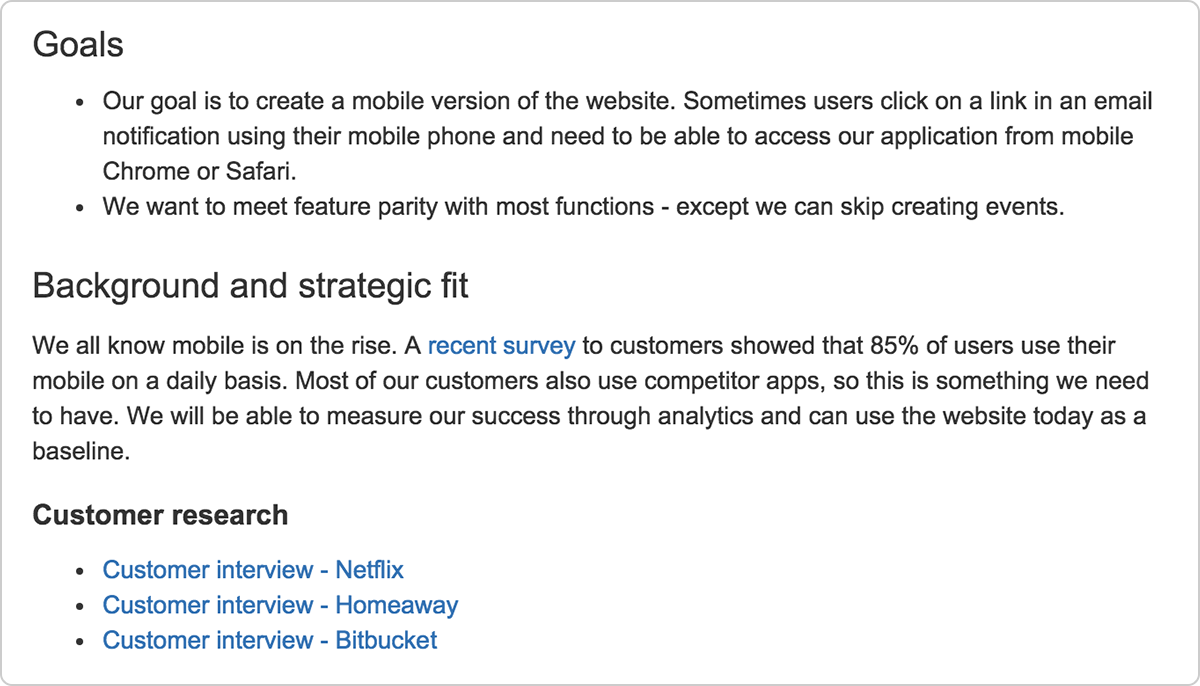
4. Assumptions
List the technical, business, or user assumptions you might be making.
5. User Stories
List or link to the user stories involved. Also link to customer interviews, and inclused screenshots of what you've seen. Provide enough particular to brand a complete story, and include success metrics.
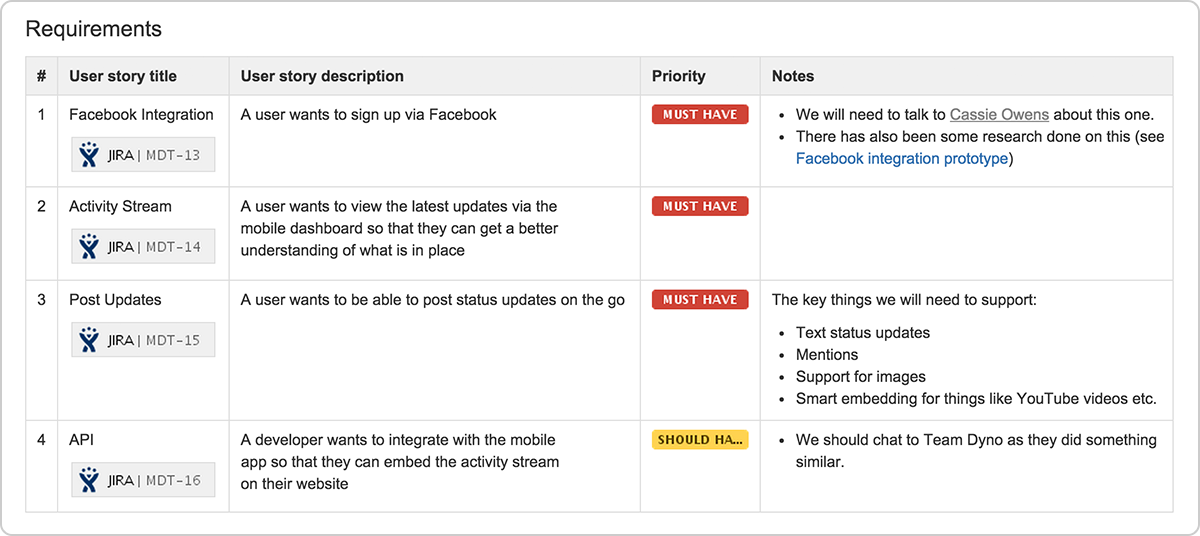
6. User interaction and pattern
After the team fleshes out the solution for each user story, link design explorations and wireframes to the folio.
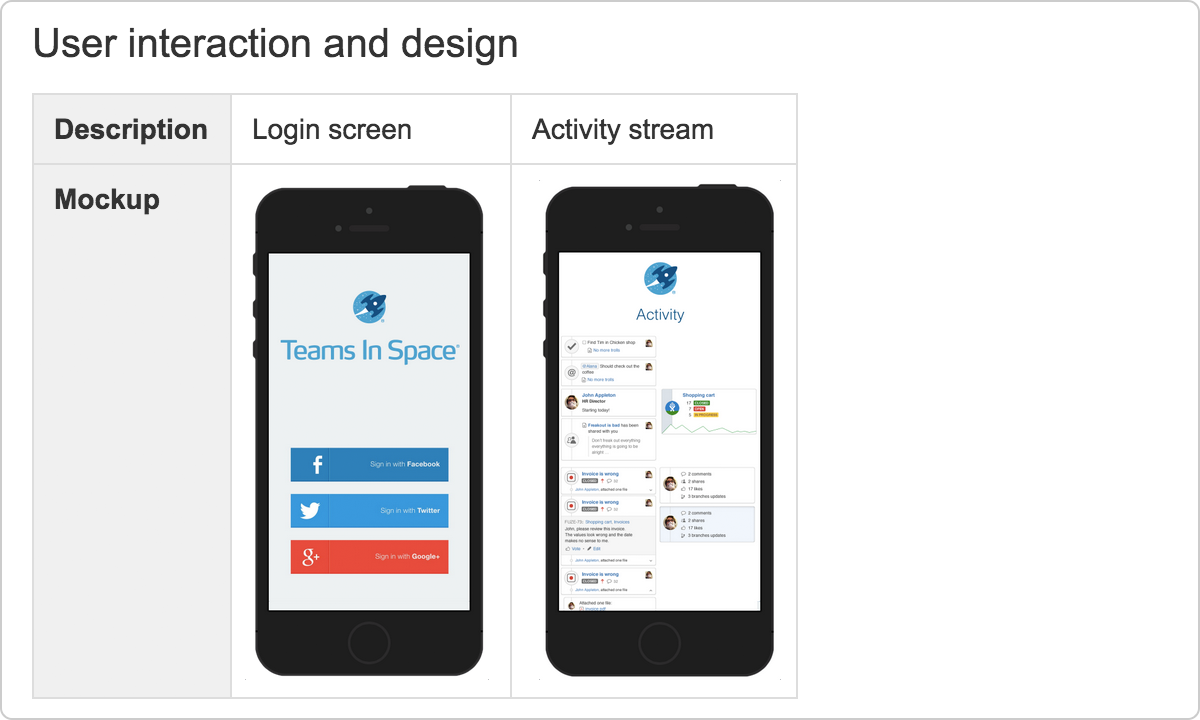
seven. Questions
As the team understands the problems to solve, they ofttimes have questions. Create a table of "things we need to decide or enquiry" to track these items.
viii. What we're non doing
Keep the team focused on the work at hand by conspicuously calling out what you're not doing. Flag things that are out of scope at the moment, simply might exist considered at a later fourth dimension.
Pro Tip:
The Active Manifesto reminds usa that nosotros can be flexible with how we create requirements. Some teams do user story mapping exercises to place problems and solutions. Sometimes the full product triad (product owner, programmer, and designer) visits a customer and then brainstorms solutions to a item problem that the customer mentioned.
No matter how requirements are born, it'south important that the squad considers them to be one of many means they can define and communicate client bug. See our section on agile design to learn how product owners tin can use Keynote and Powerpoint to mock-up existent experiences equally requirements.
Example of a 1-page PRD
Here's a await at a fully fleshed out production requirements document that we created using Confluence. Retrieve, no two production requirements will exist exactly the same. Use this case to understand the different elements that should be included in your PRD, just non as the definitive fashion to do it.
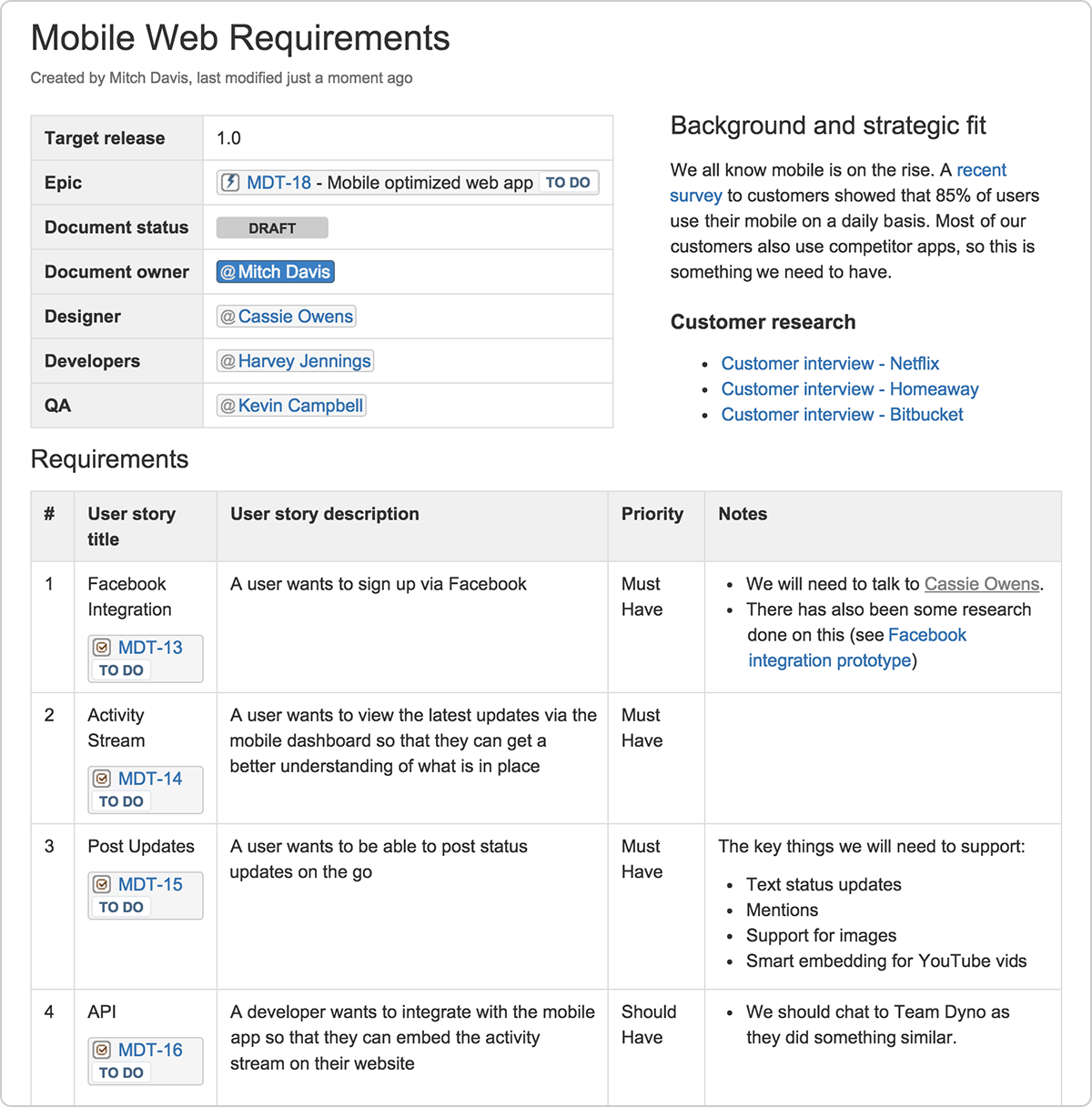.png?cdnVersion=600)
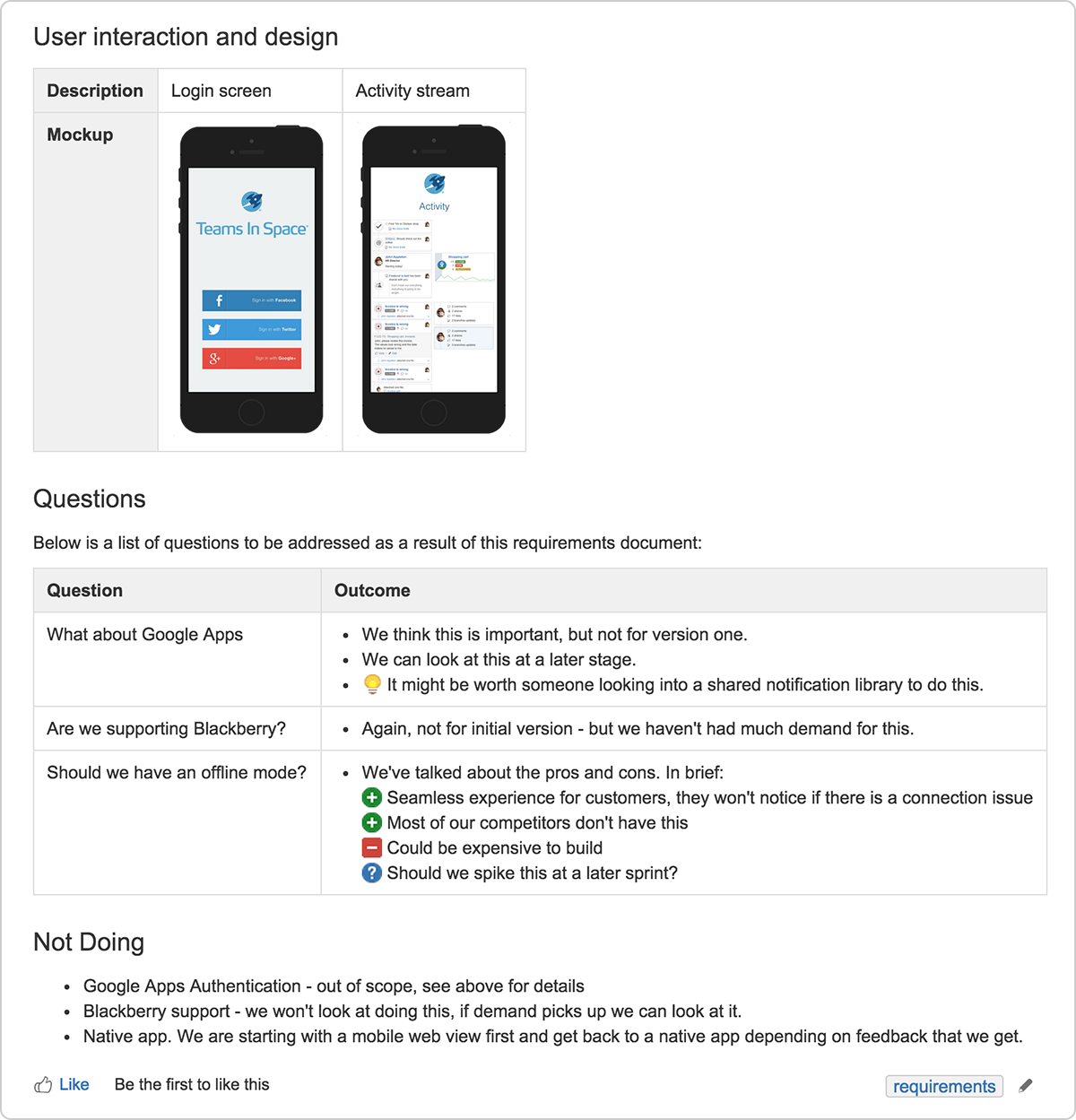.png?cdnVersion=600)
Central takeaways from the one-page approach:
If you are to take away anything from this weblog, understand the "why" – the not "what" – because the "why" will help you explore what is all-time for your squad. Hither are the benefits and challenges nosotros've observed with the i-page dashboard approach:
one. One page, 1 source
Keeping information technology unproblematic. The product requirements document becomes the "landing page" for everything related to the prepare of issues within a particular epic. Having something that is the central go-to location saves your team members time in accessing this information and gives them a concise view.
2. Extra agility
One of the awesome things near using a uncomplicated folio to collaborate (verses a dedicated requirements management tool) is that you lot can be active most your documentation! You don't have to follow the same format every fourth dimension – do what you need, when you lot need it, and be agile nearly it. Chop and change equally needed.
iii. Only plenty context and detail
We oft forget how powerful a simple link can be. Nosotros embed a lot of links within our product requirements documents. It helps abstruse out the complexity and progressively disclose the information to the reader as needed. Linking detailed resources may include such things as:
- Customer interviews for background, validation or further context for the feature
- Pages or blogs where similar ideas were proposed
- Previous discussion or technical documentation and diagrams
- Videos of product demos or other related content from external sources
iv. Living stories
I see a lot of customers do this as well. Once the stories have been roughly thought out and entered as issues in Jira Software, nosotros link to them in our page (which, conveniently, creates a link from the issues back to the page too). The 2-way syncing between Confluence and Jira Software means we automatically go to see each issue's current condition right from the requirements folio.
5. Collective wisdom
Capturing production requirements in Confluence makes it easy for other people in different teams to contribute and make suggestions. I've been amazed at the number of times someone from another team jumped into the conversation with a comment providing great feedback, suggestions, or lessons learned from like projects. Information technology helps a big organization feel like a small squad.
half-dozen. Engaging "extras"
Diagrams fabricated with tools like Visio, Gliffy, or Balsamiq ameliorate communicate the issues to your team. You tin can likewise embed external images, videos, and dynamic content.
7. Collaboration!
The most important aspect of all this is getting everyone involved. Never write a product requirements document by yourself – you should always accept a developer with you and write it together. Share the page with your team and get feedback. Annotate, enquire questions, encourage others to contribute with thoughts and ideas. This is especially important for distributed teams who don't often get a chance to discuss projects in person.
Challenges
With every approach there are downwardly-sides. Here there are 2 main challenges nosotros've experienced and observed from customers likewise:
1. Documentation can go stale
What happens when you implement a story and become feedback and then change the solution? Does someone get back and update the requirements folio with the last implementation? This is a challenge with any type of documentation, and it'south always worth questioning whether such trade-offs are worthwhile. Talk to your team nearly what you would do in a scenario like this.
2. Lack of participation
"What can I practice to encourage people to annotate?", "How can I encourage people to write more specs and stories on our intranet?". This is a tough nut to cleft, and it comes down to various wiki adoption techniques in your organization. There are plenty of resources to assist you here. There may be deeper cultural problems at play here, too.
Now get to work!
When requirements are nimble, the product possessor has more time to understand and keep pace with the market. And keeping them informative-but-brief empowers the evolution team to use whatever implementation fits their architecture and technology stack best.
One time a project'due south requirements are reasonably well-baked, we recommend linking the user stories in section five to a higher place to their corresponding stories in the development squad's result tracker. This makes the development process more transparent: it'due south easy to run across the status of each piece of work, which makes for more informed decisions from the product owner, also equally downstream teams like marketing and support.
ProTip:
Don't runway the user stories that come up from project requirements in one organisation and defects in some other. Managing work across two systems is needlessly challenging and just wastes time.
Remember, be agile in your evolution of requirements for a project. It'southward okay to change user stories as the team builds, ships, and gets feedback. E'er maintain a high quality bar and a good for you engineering culture –even if information technology ways shipping fewer features.
Try Jira Product Discovery for free
Oz In Pitcher Of Beer,
Source: https://www.atlassian.com/agile/product-management/requirements
Posted by: mossstrater.blogspot.com



0 Response to "Oz In Pitcher Of Beer"
Post a Comment